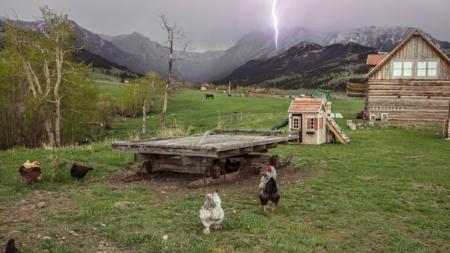The Forever Ranch
Learning to coexist with the wild in Montana’s Tom Miner Basin.
All photos by Louise Johns
Julie Anderson will never forget the night wolves killed her family’s border collie. She’d let Spud out one autumn evening in 1996 to do his business. After a few minutes, Julie and her husband, Hannibal, heard a ruckus and ran to the back porch, frantically calling for him. They heard him cry, the sound of yipping wolves, then silence across Tom Miner Basin, a small, remote ranching community in Montana surrounded by mountains on the northwest border of Yellowstone National Park.
These were some of the first wolves to disperse from Yellowstone National Park after their reintroduction in 1995, and the packs soon made their way to Tom Miner Basin as they learned their new home territory. Most Rocky Mountain ranchers vehemently opposed the reintroduction of wolves and believed (as some still do) they were going to ruin their way of life. The Andersons supported not only the wolves but also all the wildlife that lives in the Yellowstone ecosystem.
“So, now how do we feel about the wolf reintroduction?” Hannibal asked Julie, and their sons, Andrew, 16, and Daniel, 12, as they sat on the porch that night weeping for the loss of their beloved herding dog. They were silent for a while. Julie recalls how they talked it over as a family and agreed that they needed to accept it as part of nature and move on. “That was the moment we needed to own our philosophy,” says Daniel, now 37. “And we did.”
After the Andersons lost three more dogs and several sheep to carnivores, they decided that the sheep needed to go. “That’s when we really came to the realization that maybe it’s just not smart to be raising sheep in the Yellowstone ecosystem with wolf reintroduction,” Julie says. The family’s resolve to adapt to nature rather than impose on it has guided every decision they’ve made since.
“Coexistence isn’t about comfort,” says Hannibal. “It’s about recognizing that there are various forces working throughout this system and those forces operate in dynamic ways. We don’t get to decide which of those we’re OK with and which ones we’re not.”
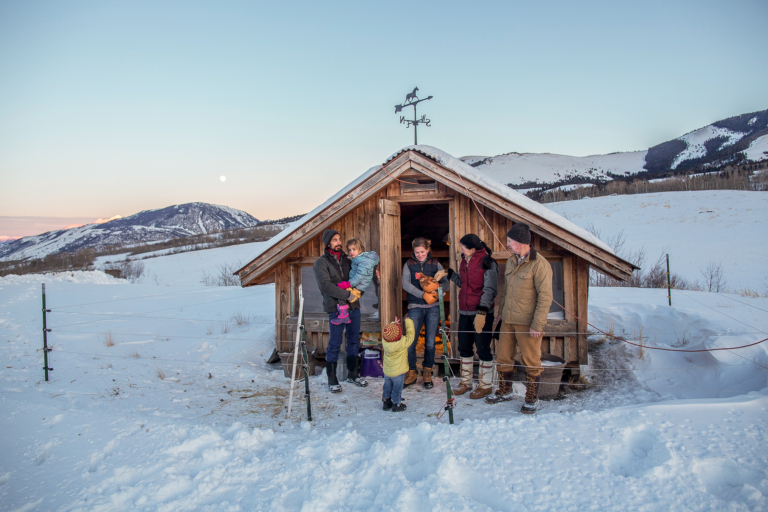
Julie and Hannibal Anderson (right) tend to the chickens with their daughter Malou Anderson-Ramirez (center), her husband Andres Ramirez and two grandchildren. The chicken coop on the Anderson Ranch is enclosed with hot electric wire to protect the chickens and avoid conflicts with wolves and grizzly bears.
In 1955, Hannibal’s parents, Virginia and Andy Anderson, settled in Tom Miner Basin alongside a handful of other working cattle ranchers. A bomber pilot in World War II, Andy, who was originally from Wisconsin, escaped to the West after the war and married Virginia, who came from upstate New York. “My father wanted to be part of something wild,” Hannibal says. Virginia and Andy stayed in Tom Miner for the rest of their lives, raising four boys. Virginia considered the basin to be a “spiritual asset” for herself and her family, and she passed along a respect and honor for the landscape to her children and grandchildren, an ethos that the following generations have wholeheartedly embraced.
Throughout the American West, many agricultural communities have struggled to make a living on the land. This is in large part due to the global forces affecting rural America: fluctuating commodity prices, climate change and land development, all linked to a history of extractive practices. The consolidation of agriculture into big corporations has made it harder for small farms and ranches to make a real go of it. Today, when land goes up for sale in a place like Tom Miner Basin, only the ultrawealthy can afford it or the ecosystem becomes further fractured through corporate subdivision.
Today, the Andersons graze cattle for nearby cattle ranches in the summer months and keep a small herd of Hereford cow-calf pairs that are owned and managed by family members who live on the lower end of the ranch. “Our practices are based around land, instead of how much we can get out of this pasture, or how much hay we can grow and consume,” says Malou Anderson-Ramirez, Hannibal and Julie’s 39-year-old daughter.
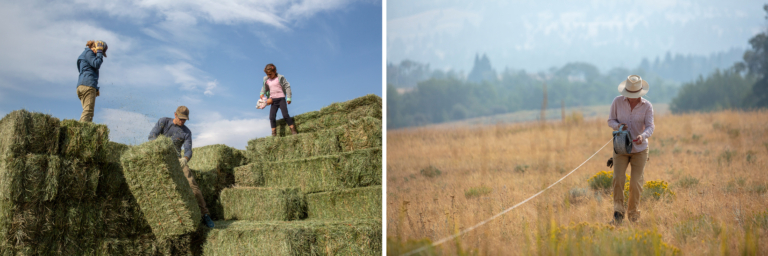
Left: Malou and her brother Daniel Anderson work together to stack hay bales that will feed livestock through the winter. Her daughter, Esme, plays on the haystack.
Right: Malou rolls up electric fence wire used for making mobile paddocks for livestock grazing on her family’s ranch.
The main chores on the ranch include using electric fences to make small pastures where cattle can graze for a few days, grind the soil with their hooves and then be moved on. The other continuous project is manually pulling weeds, such as houndstongue and hoary alyssum, which will outcompete the native grasses within a year’s time if they’re not dealt with. “We’re trying to help an overall natural system that is already at work,” Malou says. “We’re just sort of bumping it along and helping it along without trying to change or dominate it with spraying.”
The Anderson Ranch has also become a laboratory for experimenting with soil and rangeland health, learning how to reduce conflicts with predators and low-stress livestock handling, which ensures that horses and cattle are living in healthy partnerships with their human counterparts. Almost every year the Andersons host workshops on each of these topics for the local and regional community to participate in.
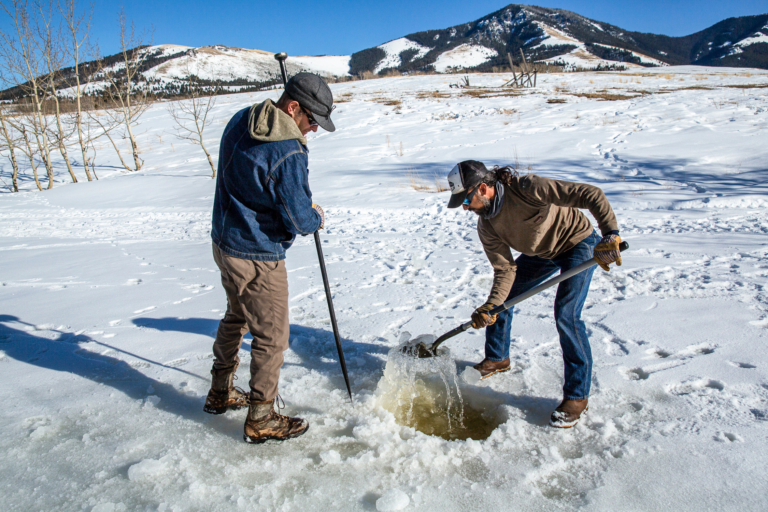
Daniel and his brother-in-law Andres break a hole in the ice for horses to drink from on the Anderson Ranch.
These days it’s nearly impossible to make a living only from cattle or the land, especially in a place like Tom Miner Basin, where most of the cattle are shipped out for the winter due to the harsh alpine climate and freezing temperatures. The Andersons have made it work by diversifying their income and activities related to ranching. Hannibal and Julie have both had careers off the ranch, working in healthcare and education, most recently traveling back and forth to serve Yup’ik and Inuit communities in rural Alaska. Malou and her husband, Andres Ramirez, and their two young girls live full time on the ranch. Andres built two immaculately crafted tiny houses from reclaimed wood and materials on the ranch that are used for Airbnb rentals in the summer months.
“Because we aren’t completely dependent upon the land economically, it allows us to be more open and explorative, tolerant and creative,” says Malou. “We never grew up with the place as a financial asset. It was always an added benefit for our lives and for us to take care of.”
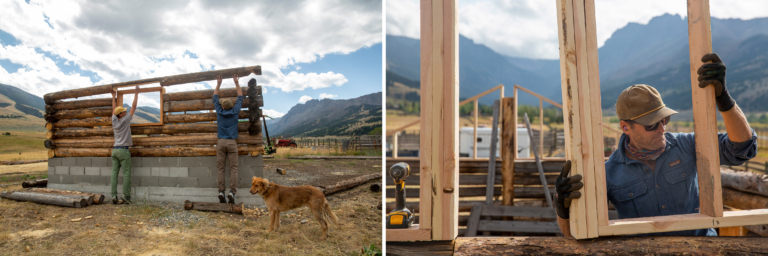
Left: Daniel (right) and Tim Johns lift a log onto the next section of the barn they are rebuilding and restoring on the Anderson Ranch. The logs come from the first schoolhouse built in Tom Miner Basin in the late 1800s.
Right: Something old, something new—Daniel builds the frame for an old barn he’s restoring and making better than new.
Julie and Hannibal live in a stone home built in 1902, the same home where Malou, Daniel and their three siblings were raised. Julie’s vision when she first married Hannibal and began living in the Basin was to restore every building on the ranch in her lifetime. In the summer of 2020 that vision was realized. Her son Daniel rebuilt the small log horse barn, which is one of the oldest buildings in the Basin and the last of the five original ranch buildings that have been restored. The Anderson’s sheep were the last to use it more than two decades ago.
“The notches in those logs were done by hand, and they were done with perfection,” Daniel says, proudly. “To me, the value in restoring these old buildings is maintaining the historical continuity of a place. Doing this work is incredibly rewarding and humbling.”
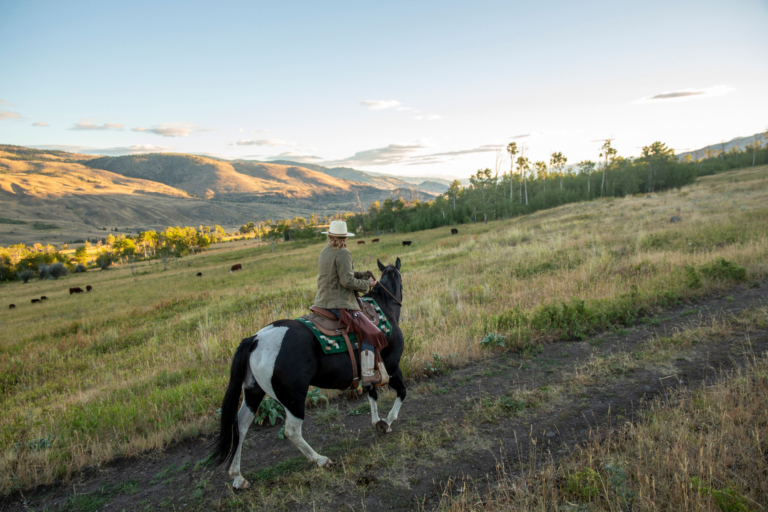
Malou rides her horse Benny to check the herd for sick animals and to look for signs of wildlife. “Coexistence is honoring the spirit and the struggle of what it takes to survive up here,” she says. “Whether that’s the people and community, the wolves, the bears or the elk.”
